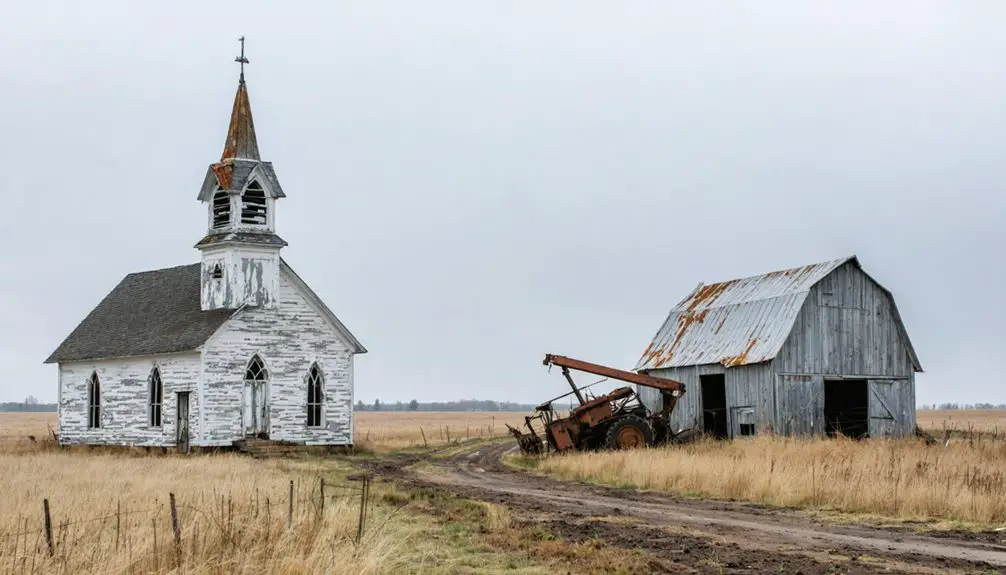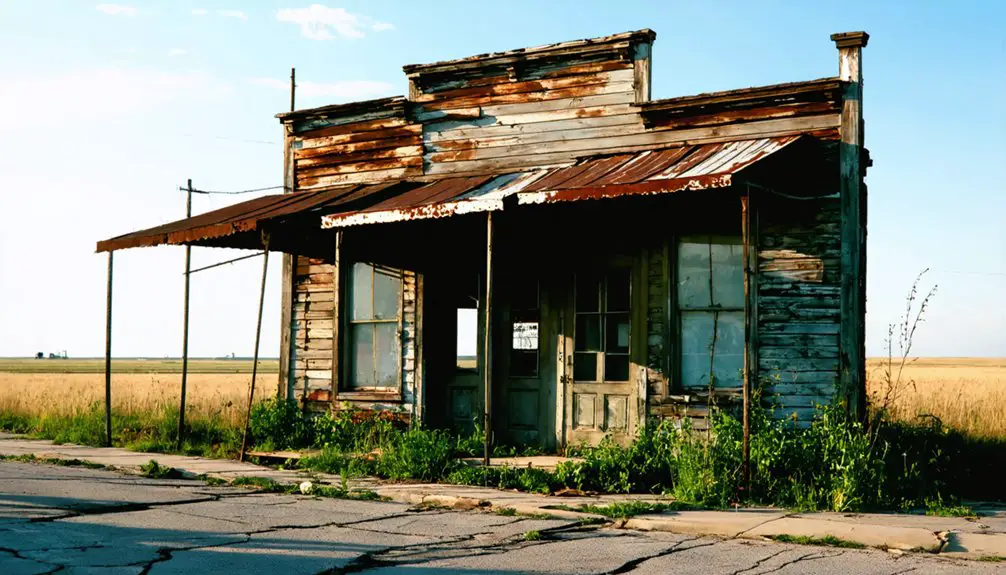You’ll find Factoryville’s ghost town site at 40°48′N 95°58′W along Nebraska’s old Lincoln-Union Highway. Founded in 1856 by George Hunt, this once-thriving settlement boasted a flour mill, Methodist college, and two blacksmith shops. When the railroad laid tracks across Weeping Water Creek in 1887, businesses relocated, leading to the town’s abandonment by the 1890s. Today, only ground depressions mark where buildings once stood, but Factoryville’s story reveals vital lessons about frontier town survival.
Key Takeaways
- Factoryville was established in 1856 along Weeping Water Creek and thrived as a frontier settlement with a flour mill and Methodist college.
- The town’s decline began in 1887 when railroad tracks were laid on the opposite side of Weeping Water Creek.
- By the 1890s, Factoryville was completely abandoned as businesses and residents relocated to nearby rail-connected towns.
- No original structures remain at the site today, with only ground depressions marking where buildings once stood.
- The ghost town site is accessible via 2WD roads along the old Lincoln-Union Highway at coordinates 40°48′N 95°58′W.
The Rise of a Frontier Settlement
While westward expansion swept across the American frontier in the 1850s, Factoryville emerged as a strategic settlement along Nebraska’s Weeping Water Creek.
The settlement dynamics began when George Hunt recognized the creek’s water-power potential in 1856, establishing a foundation for what would become a bustling frontier community.
You’ll find pioneer challenges were met head-on as settlers carved out transportation routes, linking their new home to Nebraska City and Plattsmouth through primitive trails. Similar to modern-day Factoryville’s access to State Routes 6 and other vital roadways.
Named by Isaac Pollard during his travels to Washington, D.C., Factoryville grew into an essential hub with a flour mill, stores, hotels, and even a Methodist college.
Factoryville’s evolution from frontier settlement to thriving commercial center showcased the entrepreneurial spirit of America’s westward expansion.
The U.S. government’s grant of a post office in 1875 cemented the town’s status as a regional center, marking its transformation from frontier outpost to established community.
Located 18 miles south of Plattsmouth, the settlement was positioned on high land surrounded by fertile farmland and timber.
Early Development and Town Life
As Factoryville took shape in the 1860s, you’d find a bustling community centered around the frame flour mill that anchored the town’s early economy.
Settler experiences included breaking tough prairie sod while battling harsh weather conditions, from drenching spring rains to devastating summer droughts. Much like the success of Kirkpatrick’s saw mill in nearby Cass County, the flour mill became essential to local development. The town grew to include two blacksmith shops that served the local farming community.
Educational Legacy and Community Growth
In the 1860s, Factoryville College emerged as a pioneering educational institution that would shape the town’s identity and growth trajectory. The Methodist-sponsored college’s educational influence extended beyond academics, as it fostered a progressive community identity by welcoming women and offering ambitious programs in arts, science, law, medicine, agriculture, and theology. Like Methodist leader Evans, the college emphasized social betterment and educational opportunities for all.
You’ll find evidence of the college’s impact in the town’s physical development, from the trails and wooded areas to the infrastructure that grew around campus. Similar to Spring Ranch Campground, the area now offers visitors a chance to explore historical sites while enjoying nature.
While the institution struggled to fully realize its grand vision, with many planned buildings remaining unbuilt, it positioned Factoryville as a regional center for learning. The college’s presence attracted families seeking educational opportunities, sparked cultural activities, and established the town as a hub for Methodist values and progressive education in 19th-century Nebraska.
Transportation’s Role in Town Decline
You’ll find Factoryville’s fate was sealed in 1887 when the railroad chose to lay tracks on the opposite side of Weeping Water Creek, effectively cutting off the town from crucial transportation routes.
While neighboring towns like Nehawka prospered by securing railroad stations through strategic land deals, Factoryville’s physical separation by the creek prevented it from participating in the region’s rail-based commerce.
The town’s reliance on primitive trails and wagon transport proved inadequate against rail-connected competitors, leading to its rapid abandonment by the 1890s as businesses and residents relocated to communities with direct rail access.
Railroad Location Impact
When the railroad was constructed on the opposite side of Weeping Water Creek instead of Factoryville, it sealed the town’s fate. The railroad’s significance went far beyond transportation – it determined which towns would thrive and which would fade into obscurity.
You’ll find that Factoryville’s businesses and residents quickly relocated closer to the rail line, understanding that their economic survival depended on it. The railroads typically received every other square mile of land along their tracks, giving them enormous influence over settlement patterns.
The economic consequences were devastating. Without rail access, Factoryville’s mills couldn’t compete with neighboring towns like Nehawka that enjoyed direct railroad connections.
Isolation From Trade Routes
Beyond the railroad’s absence, Factoryville suffered from broader transportation isolation that crippled its economic prospects.
The town’s trade route isolation became increasingly apparent as neighboring communities like Union and Nehawka attracted commerce through their superior connectivity.
Like many of Grant County’s early settlers who relied on sod houses for shelter, Factoryville’s inhabitants faced severe infrastructure limitations.
You’ll find that Factoryville’s transportation challenges created cascading economic effects:
- Limited stagecoach and wagon routes failed to compensate for missing rail links, severely restricting goods movement.
- The Lincoln-Union Highway proved insufficient without complementary transport options.
- Unpaved, poorly maintained roads deterred automobile traffic as motor vehicles gained popularity.
- The physical barrier of Weeping Water Creek separated the town from essential shipping corridors.
These limitations forced local industries to rely on outdated transport methods, making it impossible to compete with better-connected towns in the regional economy.
Similar to how railroads and automobiles caused many Nebraska prairie towns to decline, Factoryville’s lack of modern transportation ultimately sealed its fate.
Shifting Economic Patterns
The railroad’s transformative impact on Nebraska’s economic landscape spelled disaster for Factoryville’s future.
You’ll find that the town’s economic shifts directly mirrored the transportation evolution sweeping across the prairie. When the railroad bypassed Factoryville, choosing the opposite side of Weeping Water Creek, the town’s merchants and farmers lost their competitive edge.
Without rail access, you couldn’t maintain the robust trade that once flowed through Factoryville’s streets. The flour mill and agricultural shipments that sustained the town became increasingly difficult to move by wagon alone. Much like Union Pacific Railroad in Ames, Nebraska proved essential for shipping success in the 1880s, Factoryville suffered without such vital infrastructure.
While neighboring rail-connected towns prospered from mining and mineral transport, Factoryville’s businesses emptied. By the 1890s, the workforce had relocated to communities with rail service, leaving behind a stark reminder of how transportation access determined a town’s survival.
Notable Landmarks and Structures
Landmarks in Factoryville, Nebraska centered around industrial and educational institutions that defined the town’s character during its brief existence.
The architectural styles reflected the town’s pioneering spirit, from the industrial heritage of its flour mills to the dignified presence of Factoryville College.
- The cornerstone flour mill, established in 1859 along the Weeping Water River, served as the town’s economic engine.
- Factoryville College’s Methodist campus stood as a beacon of higher learning.
- The post office, established in 1868, anchored the town’s communication hub.
- Two blacksmith shops and several general stores lined the Lincoln-Union Highway.
You’ll find traces of these structures today only in ground depressions and scattered ruins, silent witnesses to a once-thriving community that flourished before the railroad’s fateful bypass.
Modern Ghost Town Status and Historical Impact

Today, you’ll find virtually nothing standing at Factoryville’s original site except ground depressions where buildings once stood along Highway 34 near Weeping Water Creek.
The town’s economic downfall, triggered by the railroad’s construction on the opposite side of the creek in the 1880s, mirrors countless other Nebraska settlements that vanished after being bypassed by crucial transportation routes.
While Factoryville’s physical structures have disappeared, its legacy lives on through preserved records of its Methodist college, post office operations, and commercial ventures that once made it a promising frontier community.
Modern Site Remains
Modern visitors to Factoryville’s abandoned site will find only subtle depressions in the earth marking where buildings once stood along Weeping Water Creek.
The site conditions reflect Nebraska’s typical climate, with hot summers and snowy winters impacting the terrain throughout the year.
While visitor accessibility remains straightforward via 2WD roads along the old Lincoln-Union Highway alignment, you’ll discover a landscape that’s been reclaimed by rural agricultural use.
The ghost town’s physical remnants tell the story of its railroad-induced decline:
- Zero standing structures remain from the original settlement
- Earth depressions mark former building locations near the creek
- No infrastructure exists from the once-thriving mill town
- The site lies between modern Union and Nehawka, offering clear reference points for exploration
Lost Town’s Economic Legacy
While Factoryville’s physical remains have vanished into Nebraska’s agricultural landscape, its economic story offers essential insights into how 19th-century railroad development shaped the fate of frontier communities.
You’ll find that Factoryville’s initial economic sustainability relied on a robust flour mill, Methodist college, and position as a local trade hub.
However, when railroad planners chose a route across Weeping Water Creek, they unknowingly sealed the town’s fate. The lack of rail access devastated Factoryville’s community resilience, causing businesses to relocate and the mill to cease operations.
Today, Factoryville stands as a monument to how transportation infrastructure could make or break a frontier town’s survival, a pattern that played out across countless similar communities during America’s westward expansion.
Preserving Factoryville’s Memory
Despite its complete physical disappearance from Nebraska’s landscape, Factoryville’s legacy persists through dedicated preservation efforts and historical documentation.
Through community storytelling and historical preservation initiatives, you’ll find the town’s memory lives on in various forms:
- Digital archives and historical publications maintained by the Cass County Historical Society document Factoryville’s evolution from a bustling settlement to a ghost town.
- Maps marking the site at 40°48′N 95°58′W help you explore the former town’s location between Union and Nehawka.
- Local history projects preserve stories of the Methodist college, flour mill, and post office that once defined the community.
- Historical articles and archival records detail how railroad developments in the 1890s led to the town’s eventual abandonment, offering insights into Nebraska’s settlement patterns.
Frequently Asked Questions
Were Any Notable Crimes or Dramatic Events Reported in Factoryville’s History?
Down to brass tacks, you won’t find any unsolved mysteries or ghost sightings in historical records. Research shows zero notable crimes or dramatic events occurred during Factoryville’s active years from 1850s-1890s.
What Happened to the Methodist College’s Records and Student Archives?
You won’t find the college records or student archives today – they’ve likely been lost to time, with no evidence of transfer to historical societies or Methodist church repositories.
How Did Native American Tribes Interact With Early Factoryville Settlers?
You’ll find limited evidence of cultural exchanges between tribes and settlers, with mostly peaceful but sparse interactions focused on basic trade agreements rather than sustained relationships along Weeping Water Creek’s trading paths.
What Was the Highest Recorded Population of Factoryville During Its Peak?
You’d think a town with such historical significance and population growth would have clear records, but there’s no exact peak population documented – estimates suggest between 150-300 residents in the 1870s-1880s.
Are There Any Remaining Artifacts or Items From Factoryville in Museums Today?
You won’t find any confirmed artifacts from Factoryville in today’s museums. Despite its historical significance, preservation efforts haven’t documented any surviving items in Nebraska’s museum collections or historical repositories.
References
- https://www.wikiwand.com/en/articles/Factoryville
- https://en.wikipedia.org/wiki/Factoryville
- https://kids.kiddle.co/List_of_ghost_towns_in_Nebraska
- https://www.nehawkanebraska.com/index.php/history
- https://history.nebraska.gov/wp-content/uploads/2017/12/doc_publications_NH1943Communities.pdf
- https://digitalcommons.unl.edu/cgi/viewcontent.cgi?article=1004&context=nebhisttrans
- http://www.kancoll.org/books/andreas_ne/cass/cass-p12.html
- http://govdocs.nebraska.gov/epubs/H6000/B009.0032-1991.pdf
- https://www.treasurenet.com/threads/factoryville.140201/
- https://occgs.com/projects/rescue/locations/nebraska/CASS County-MISC.pdf



